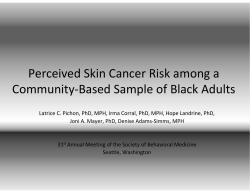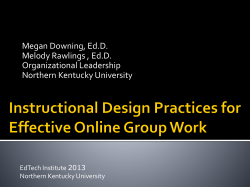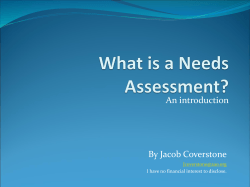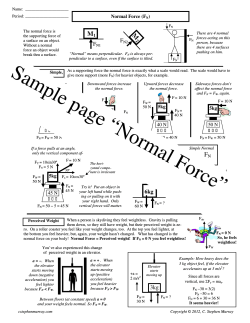
Understanding Perceived Social Support through Communication
Work-in-Progress CHI 2015, Crossings, Seoul, Korea Understanding Perceived Social Support through Communication Time, Frequency, and Media Multiplexity Donghee Yvette Wohn Abstract New Jersey Institute of Technology We asked people (N=476) about their perceived social support from three groups of friends based on how they communicate with them: those whom they communicate only face to face, only through technology, or both. We found that communication time, frequency, and the number of channels they use to communicate (multiplexity) were related to their perceived social support from each of those groups. Applications with voice (Skype, telephone) were significantly related to emotional support. University Heights GITC 5500 Newark, NJ 07102 USA wohn@njit.edu Wei Peng Michigan State University 404 Wilson Rd. Rm. 409 East Lansing, MI 48824 USA pengwei@msu.edu Author Keywords Computer-mediated communication; social support; media multiplexity; modality; friendship ACM Classification Keywords Permission to make digital or hard copies of part or all of this work for personal or classroom use is granted without fee provided that copies are not made or distributed for profit or commercial advantage and that copies bear this notice and the full citation on the first page. Copyrights for third-party components of this work must be honored. For all other uses, contact the Owner/Author. Copyright is held by the owner/author(s). CHI'15 Extended Abstracts, Apr 18-23, 2015, Seoul, Republic of Korea ACM 978-1-4503-3146-3/15/04. http://dx.doi.org/10.1145/2702613.2732866 H.4.3 Communications Applications Introduction How are communication factors such as communication time, frequency, and the types of modalities that we use (e.g., face-to-face, computer-mediated) related to how supportive we perceive the other person to be? Does time spent communicating matter more if you don’t see someone face to face? Does the type of 1911 Work-in-Progress CHI 2015, Crossings, Seoul, Korea communication application correlate with how much social support one perceives to get? In this study, we asked people to divide their friends into groups depending on how they communicated, and examined how both communication and media factors were related to their perceived social support from each of those groups. We defined friends as people who are not relatives or co-worker and looked at groups of friends based on three methods of communication. The three groups were: friends whom one only communicates with through mediated means (only CMC), friends whom one only communicates with faceto-face (only FTF), and friends with whom one communicates with using both CMC and FTF, based on their communication patterns in the past six months. Communication Time & Frequency The first factors we examined were communication time and frequency. Previous studies have found that communication time and frequency are associated with closeness in the context of games [5] and the internet in general [8]. We thus hypothesized that more communication time and frequency will be positively associated with perceived social support. H1. Communication time will be positively associated with perceived social support. H2. Communication frequency will be positively associated with perceived social support. Increased Channels email [3]. According to social presence theory, increased number of communication channels increases one’s feeling of closeness [7]. Similarly, Haythornthwaite’s media multiplexity theory suggests that people with stronger connections use more types of media to communicate [2]. We thus hypothesized that more types of media would be associated with perceived social support. H3. Number of communication channels will be positively associated with perceived social support. CMC Applications Finally, we had an open research question as to whether different types of communication applications, such as Skype, online game, online forum, email, telephone, etc. are correlated with perceived social support for those who communicate through CMC. There have been some studies that examined different applications in specific contexts. For example, Shklovski et al. [6] found that for people who moved, email helped to maintain relationships but did not help increase the depth of the relationship whereas phone calls were associated with exchange of social support. Wohn et al. [11] found that online games helped maintain and build relationships. There has been little quantitative research, however, that has examined the effect of multiple types of communication applications on perceived social support. RQ: How are different communication applications associated with perceived social support for different friend groups? Different types of media can include visually mediated face-to-face meetings as well as text-based communication, such as videoconferencing, phone, and 1912 Work-in-Progress CHI 2015, Crossings, Seoul, Korea Method Students and staff at a large Mid-western university in the United States were invited to participate in an online survey through emails randomly sent out through the registrar. Participants were entered into a raffle to receive one of 15 gift cards. The response rate was 9.6%. Participants’ age ranged from 19 to 57 (M= 28) and 63% were female. Measures For the only-CMC group, we asked participants to “think about your actual friends whom you have met in person but ONLY communicated through MEDIATED means in the past six months,” before answering questions related to their relationship with people in that group. For the only-FTF group, we told participants to, “think about your actual friends whom you ONLY communicated face-to-face in the past six months.” For both CMC and FTF, we asked, “Think of the people whom you have met in person and communicated BOTH face-to-face and through MEDIATED means in the past six months,” before answering related questions. Reminders of which group of friends they should be thinking about were provided throughout the survey. For the only-CMC and both CMC and FTF groups, we asked participants “how do you communicate with these people” and to select all that apply. The choices were online game, online discussion forum, dating website, social network site (e.g., Facebook), Skype (video-conferencing), text messaging or email, telephone calls, or other (open ended). The number of different communication medium was an aggregation of the number of mediums selected. For only-CMC friends, participants reported an average of 2.4 (SD=1.34) channels of media, with a maximum of six. For friends that participants communicated with both through CMC and FTF, the mean was 4.07 (SD=1.40) with a maximum of eight channels, including FTF. Perceived social support was based on two subscales in the collection of social provisions by Cutrona and Russell [1]. Emotional support was based on the “attachment” subscale and instrumental support was based on the “reliable alliance” subscale. We asked participants to answer these two dimensions for each type of friendship group. Positive affect was measured by 10 items from the PANAS mood scale [10]. Communication frequency was the frequency of communicating with actual friends in the designated group during the past six months. Average communication time per session was also based on the past six months. Explaining Perceived Emotional and Instrumental Support for People Who Only Communicate via CMC We ran an Ordinary Least Squares (OLS) regression looking at how frequency of communication, average time spent during communication, and number of types of channels (Media Multiplexity [2]) used during communication is associated with perceived emotional support. Positive affect was a control variable. The model (F(4, 384)= 33.02, p<.001, Adjusted R2=.25) showed that positive affect (=.15, p<.001), frequency of communication (=.20, p<.001), average time (=.29, p<.001), and number of types of media used (=.14, p=.004) were all significant positive predictors. An OLS regression looking at types of media that were used showed that using Skype or other types of video- 1913 Work-in-Progress CHI 2015, Crossings, Seoul, Korea conferencing (=.25, p<.001) and making telephone calls (=.12, p<.02) significantly increased perceived emotional support. Communicating through an online game (=.07, p=.14), discussion forum (=.04, p=.41), dating website (=-.08, p=.11), social network site (=.03, p=.56), or text messaging/email (=.05, p=.32) did not have any significant effect. An OLS regression looking at how frequency of communication, average time spent during communication, and number of types of media (Media Multiplexity [2]) used during communication is associated with perceived instrumental support also showed similar patterns of results. The model (F(4, 386)= 22.50, p<001, Adjusted R2=.18) showed that positive affect (=.16, p=.001), frequency of communication (=.11, p=.04), average time (=.26, p<.001), and number of types of media used (=.18, p<.001) were all significant factors. Looking at the types of media that predicted instrumental support, we found that communicating through an online game (=.11, p=.02), using Skype/video-conferencing (=.24, p<.001), and making telephone calls (=.16, p=.002) were all positive significant predictors. Communicating through a dating website, however, was a negatively correlated (= -.17, p<.001). Communication through online discussion forums (= .06, p=.19), social network sites (=.02, p=.76), and text messages/email (=.01, p=.78) were not statistically significant. Explaining Perceived Emotional and Instrumental Support for People Who Only Communicate FTF For people whom participants only communicated with FTF, an OLS regression explaining perceived emotional support showed that positive affect (=.17, p<.001), frequency of communication (=.31, p<.001), and average time spent per communication session (=.27, p<.001) were all positively related to how much emotional support they felt, F(3,316)= 36.13, p<.001, Adjusted R2=.25. An OLS regression looking at how frequency of communication and average time spent during communication is associated with perceived instrumental support showed that positive affect (=.19, p<.001), frequency of communication (=.37, p<.001) and average time spent per communication session =.18, p<.001) is positively related with perceived instrumental support, F(3,314)= 36.02, p<.001, Adjusted R2=.25. Explaining Perceived Emotional and Instrumental Support for People Who Communicate Both CMC and FTF We ran an OLS regression looking at how frequency of communication, average time spent during communication, and number of types of communication channel used by the individual is associated with perceived emotional support. The model (F(4, 449)= 26.38, p<.001, adjusted R2=.18) showed that positive affect (=.24, p<.001), frequency of communication (=.17, p<.001), average time spent per communication session (=.17, p<.001) were associated with perceived emotional support in a statistically significant manner. The number of types of 1914 Work-in-Progress CHI 2015, Crossings, Seoul, Korea communication channels used (=.19, p<.001) was also a significant positive predictor; using more different ways of communication increased perception of emotional support. communication and time spent during each communication session equally contribute to perceived emotional and instrumental support, supporting H1 and H2. An OLS regression looking at specific types of communication channels that were used, showed that using text messaging or email (=.20, p<.001) was the only significant factor related to perceived emotional support. Neither face-to-face (=.07, p=.15) nor any other type of mediated communication means was significantly associated with emotional support. However, for perceived social support among CMC-only friends, the effect of time was stronger than frequency. This was not the case for friends that one communicates only FTF. For both emotional and instrumental support, frequency of communication was a stronger predictor than time. For friends that one communicates with only through mediated means, communication time was a stronger predictor than communication frequency of both perceived emotional and instrumental support. These results provide further support for social information processing theory [9] which posits that CMC can achieve the same results as FTF, but it takes more time. An OLS regression model predicting perceived instrumental support (F(4, 451)= 26.42, p<.001, Adjusted R2=.18) showed that positive affect (=.24, p<.001), frequency of communication (= .11, p=.01) and average time spent communicating per session (=.21, p<.001) were both positive significant predictors. The number of types of communication forms used =.21, p<.001) was also a positive predictor. Of the different specific types of communication used, an OLS regression showed that face-to-face (=.10, p=.02) and using text messaging or email (=.25 p<.001) were positively significant predictors of perceived instrumental support. However, communicating through a dating website (= -.17, p<.001) was a significant negative predictor. No other type of mediated communication was significantly associated with perceived instrumental support. Discussion Regarding friends that one communicates with both FTF and through CMC, we found that frequency of Our findings supported Haythornthwaite’s multiplexity theory—in the two groups that used CMC to communicate, using more channels/media applications, was positively related to higher perception of social support. H3 was supported. Our exploratory research question examining the types of media that were used during CMC and their relation to perceived social support suggests that for friends that one communicates only through mediated means, spoken communication is related to perceived emotional support. This was consistent with findings of Shklovski et al. [6] even though our participants were asked to think about all the friends they communicated with CMC and were not in a unique situation of having relocated. However, although we know that Skype and phone calls are positively related to perceived 1915 Work-in-Progress CHI 2015, Crossings, Seoul, Korea American Society for Information Science. 49, 2 (1998), 1101–1114. emotional support, whether or not this is due to speaking, listening, or both, is uncertain. While online game communication was not significantly related to emotional support, it was significantly related to instrumental support, providing further support towards literature about how games can foster social capital [4, 11]. 4. Kobayashi, T. Bridging Social Capital in Online Communities: Heterogeneity and Social Tolerance of Online Game Players in Japan. Human Communication Research. 36, 4 (2010), 546–569. 5. Shen, C. and Williams, D. Unpacking Time Online: Connecting Internet and Massively Multiplayer Online Game Use With Psychosocial Well-Being. Communication Research. 38, 1 (2011), 123–149. 6. Shklovski, I. et al. Keeping in touch by technology: maintaining friendships after a residential move. In Proc CHI 08 (2008), 807–816. 7. Short, J. et al. 1976. The social psychology of telecommunications. John Wiley & Sons. 8. Valkenburg, P.M. and Peter, J. Preadolescents’ and adolescents' online communication and their closeness to friends. Developmental Psychology. 43, 2 (2007), 267–277. 9. Walther, J.B. Interpersonal Effects in ComputerMediated Interaction: A Relational Perspective. Communication Research. 19, 1 (1992), 52–90. Future Research Contemporary mediated communication tools have the ability to converge multiple functions (e.g., text, voice, video) into one software. If number of types of channels is related to social support, does that suggest that we should be building more separate applications than converged ones? Our results suggest that adding more features to one tool may have more utilitarian but less interpersonal benefits. What is it about voice (and not visual) cues that increase perception of social support? Future research should look further into modality effects and try to pick apart the effects of the communication and the affordances of the technology. References 1. 2. 3. Cutrona, C.E. and Russell, D.W. The provisions of social relationships and adaptation to stress. Advances in Personal Relationships. 1, 1 (1987), 37–67. Haythornthwaite, C. Social networks and Internet connectivity effects. Information, Communication & Society. 8, 2 (2005), 125–147. Haythornthwaite, C. and Wellman, B. Work, friendship, and media use for information exchange in a networked organization. Journal of the 10. Watson, D. et al. Development and validation of brief measures of positive and negative affect: the PANAS scales. Journal of personality and social psychology. 54, 6 (1988), 1063–70. 11. Wohn, D.Y. et al. The “S” in Social Network Games: Initiating, Maintaining, and Enhancing Relationships. In Proc 44th Hawaii International Conference on System Sciences (2011), 1–10. 1916
© Copyright 2025









